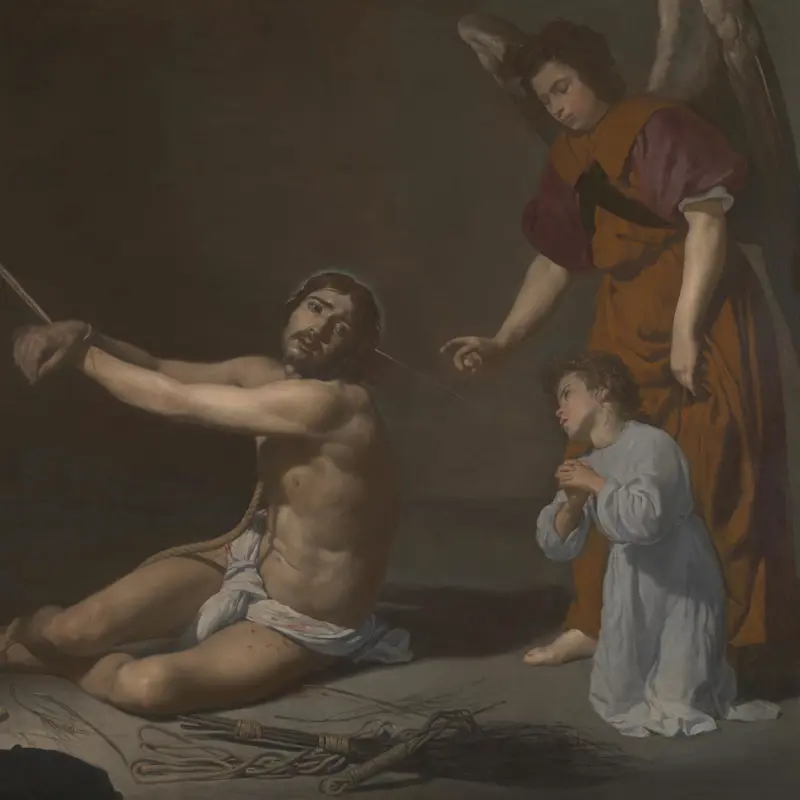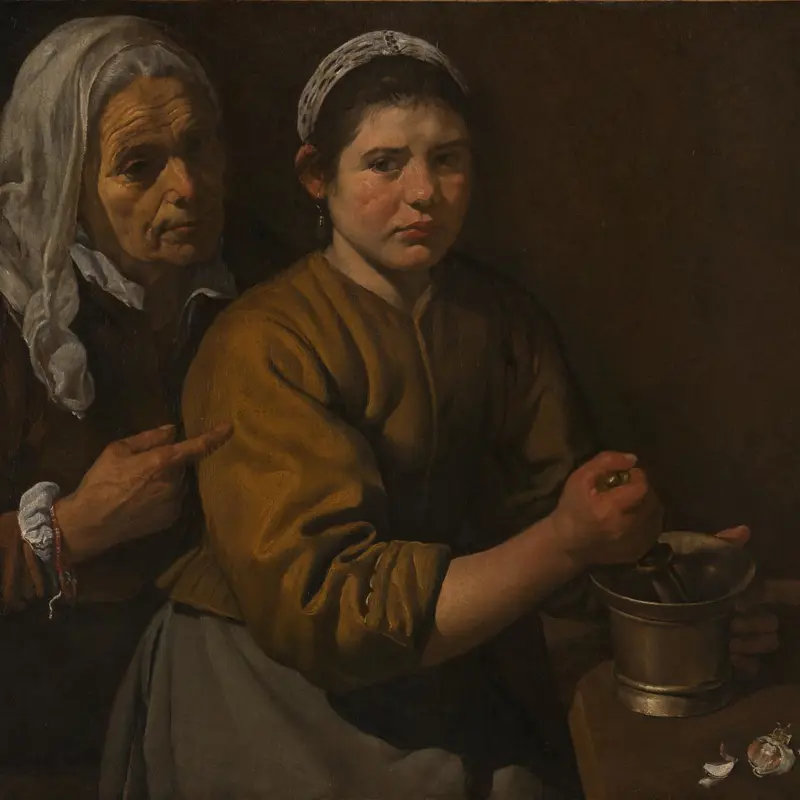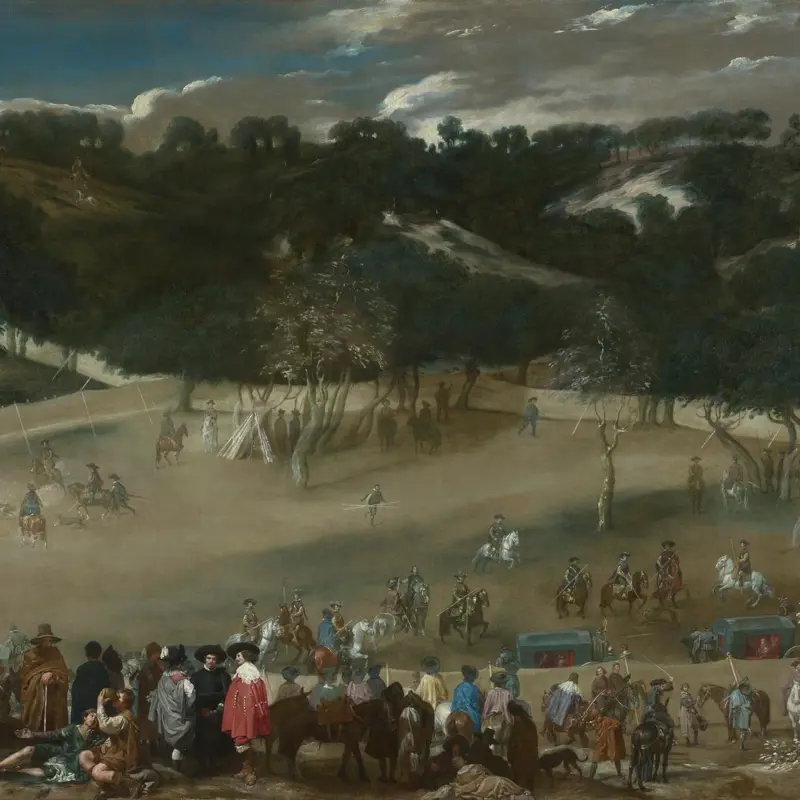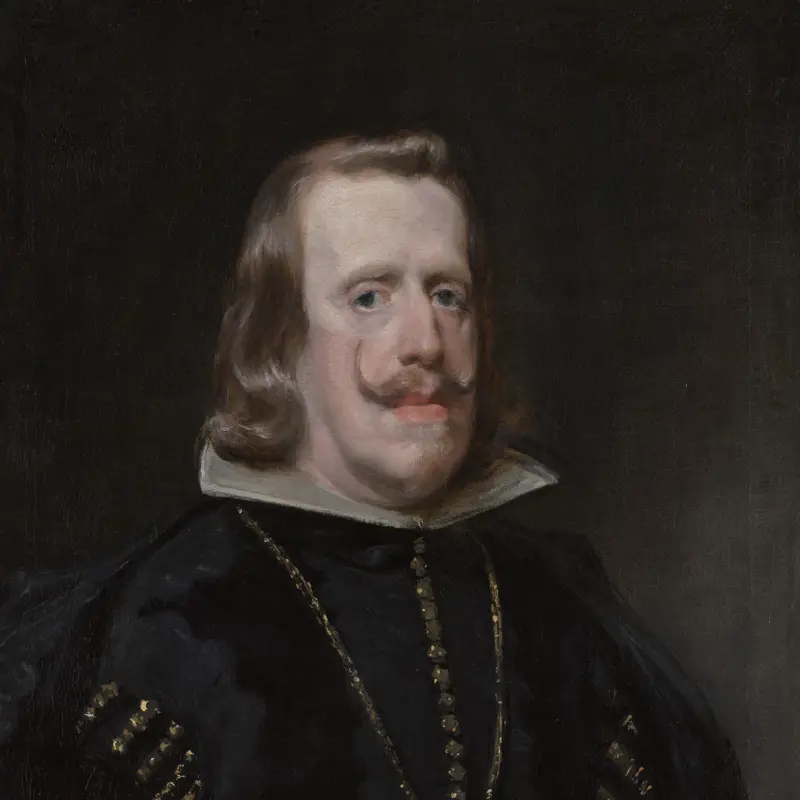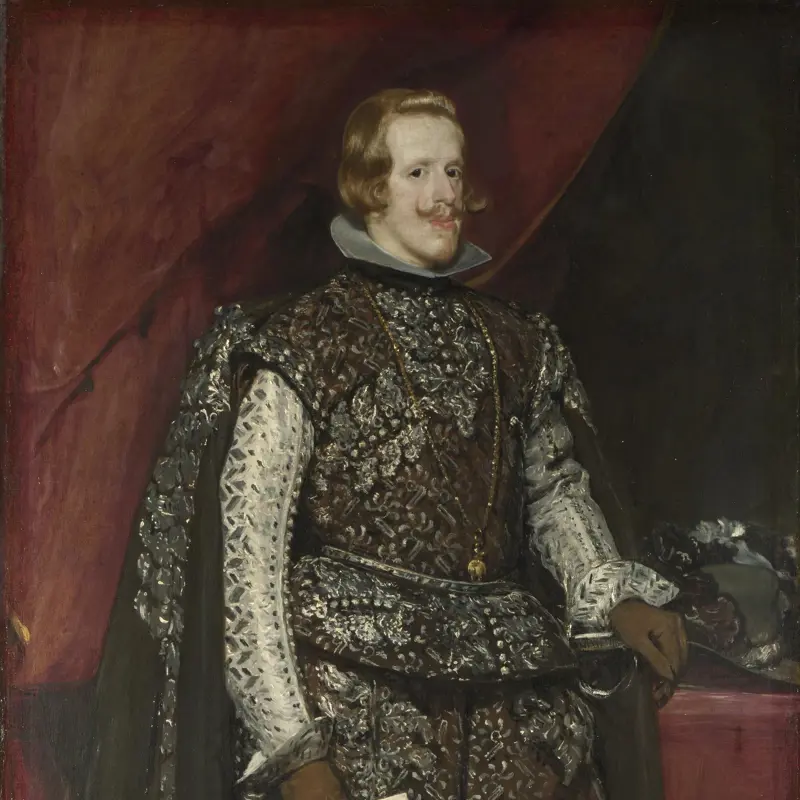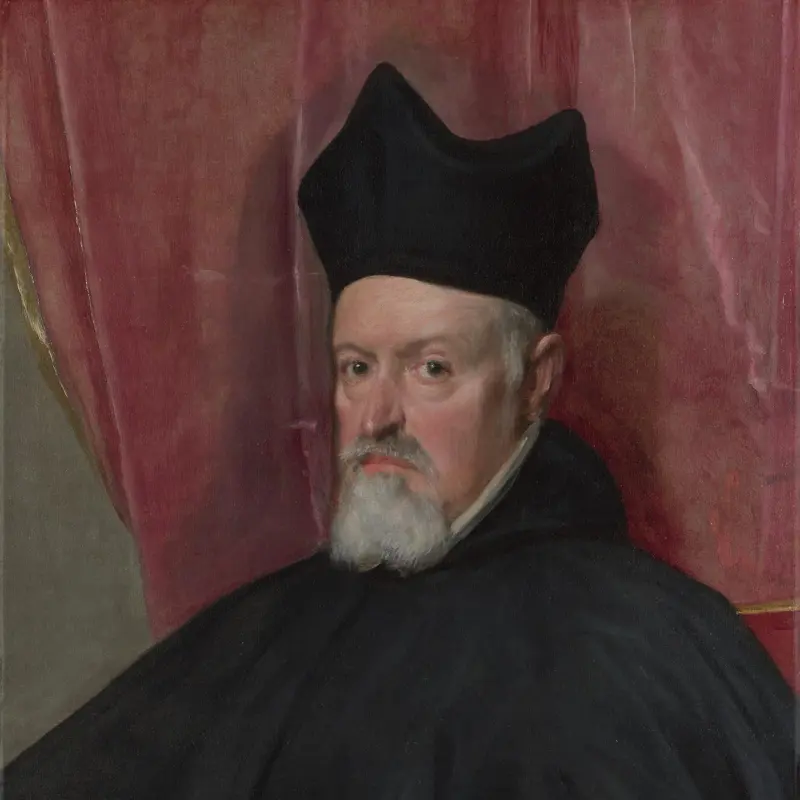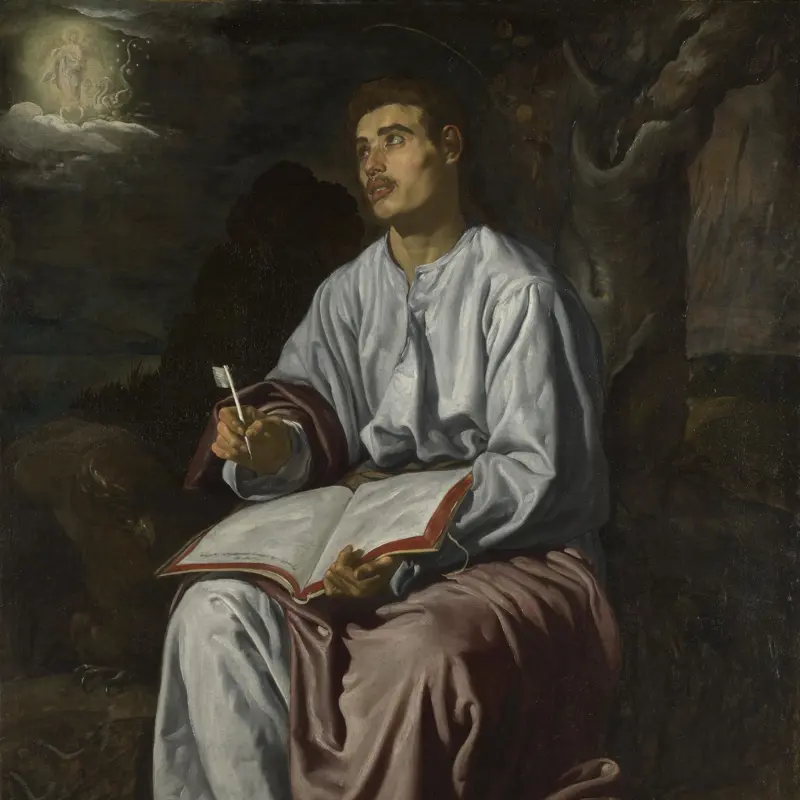Diego Velázquez, 'The Toilet of Venus ('The Rokeby Venus')', 1647-51
About the work
Overview
Venus, the goddess of love, reclines languidly on her bed, the curve of her body echoed in the sweep of sumptuous satin fabric. The pearly tones of her smooth skin contrast with the rich colours and lively brushstrokes of the curtain and sheets.
Venus‘ face is reflected in the mirror held up by her son, Cupid, but her reflection is blurred – we can’t see who she really is. Perhaps Velázquez wanted to make sure that Venus – the personification of female beauty – was not an identifiable person; we have to ‘complete’ her features with our imagination. Cupid’s face and far leg are very loosely painted and appear almost unfinished: Velázquez deliberately used a sketchy style in order to focus our attention on Venus.
This is Velázquez’s only surviving female nude and one of his most celebrated works. Its nickname, ‘The Rokeby Venus’, originates from Rokeby Park, a country house in County Durham, where the painting hung for much of the nineteenth century.
Audio description
Listen to an audio description of Diego Velázquez's 'The Toilet of Venus ('The Rokeby Venus')'
Transcript
This is a description of an impressive oil painting by the Spanish artist Diego Velazquez. Painted between 1647 and 1651 it is notably large, measuring over a meter in height and nearly two meters in width. Officially titled ""The Toilet of Venus,"" this painting is better known as the ""Rokeby Venus,"" named after where it hung at Rokeby Hall in County Durham during the 19th century. The painting features a reclining female nude on a bed, with sumptuous swathes of material draped around her – this is Venus, the goddess of love and beauty. Her back is turned to us, and there is a winged cupid figure holding up a mirror, which reveals her face to us in the reflection. At the peak of his career, Velazquez served as the chief painter to the Spanish King Philip IV, and this painting is the artist’s only surviving nude painting. Velazquez has used the background of the painting to frame and give prominence to the subjects in the painting. In the upper right-hand corner, a stark and dark grey wall serves as a backdrop, creating a sense of depth. A lavish, deep red curtain sweeps across the top left corner, enveloping the scene in opulence, and adding a sense of drama to the composition. Dominating the image, is a sensual female nude of Venus who lies on a bed that fills the foreground of the painting. She lies nonchalantly, stretched out on the bed with her head on the right, and her toes stretching to the left edge of the canvas. The curves of her body are echoed by swags of grey silk bedcovers on the white sheets beneath her. Venus is leaning with her head propped up on her right hand-her chestnut coloured hair is loosely pinned just above the
nape of her neck. She faces the mirror being held up by the winged Cupid on her left. Her head is slightly turned towards the mirror revealing a rounded, rosy cheek and a pert chin. Velazquez has painted Venus, with long, smooth brushstrokes, in pale pink and white tones, giving the figure a translucentness and a luminosity. Cupid is shown as an angelic young boy, with delicate, childlike features, with soft brown curls. He is positioned with one knee bent, kneeling at the end of the bed facing Venus. Cupid's most distinctive feature are his small white and grey feathered wings sprouting from his back. Using both hands, to hold up a rectangular black framed mirror which reflects Venus’ face. He wears a blue silky sash across his torso and holds a length of pink ribbon which drapes and curves over the frame of the mirror. This may be associated with the binding of lover’s hearts. Cupid’s gaze is cast down at his hands on the mirror. Unlike the careful attention paid to the definition of the figures and draped layers of fabric, the reflection of Venus’ face is a blur-with undefined facial features and a harsh redness to the cheeks. The fact that the viewer observes this Venus figure from behind, is what makes this such a compelling image and the only direct contact we have with her is through the reflection of her face in the mirror, which remains strangely obscure. Velazquez only left Spain twice in his lifetime. And it was during or after the second occasion he created this work. At the time that this work was made, it was forbidden to own or paint a female nude, so we don’t know who this work
was initially commissioned by. But what was Velazquez trying to convey to us with the blurring of the face in the mirror? Was his Venus a real woman whose identity he was trying to keep hidden? Is it about the transient nature of youth. Or was he inviting us to project our own idea of ideal beauty is on to her? Whatever the reasoning behind Velazquez’s artistic decisions, they will forever remain on the canvas with the Rokeby Venus.
Key facts
Details
- Full title
- The Toilet of Venus ('The Rokeby Venus')
- Artist
- Diego Velázquez
- Artist dates
- 1599 - 1660
- Date made
- 1647-51
- Medium and support
- Oil on canvas
- Dimensions
- 122.5 × 177 cm
- Acquisition credit
- Presented by the Art Fund, 1906
- Inventory number
- NG2057
- Location
- Room 30
- Collection
- Main Collection
- Frame
- 17th-century Italian Frame
Provenance
Additional information
Text extracted from the ‘Provenance’ section of the catalogue entry in Neil MacLaren, revised by Allan Braham, ‘National Gallery Catalogues: The Spanish School’, London 1988; for further information, see the full catalogue entry.
Exhibition history
-
2014Velázquez ExhibitionKunsthistorisches Museum Wien27 October 2014 - 15 February 2015Galeries Nationales du Grand Palais25 March 2015 - 13 July 2015
-
2024National TreasuresWalker Art Gallery10 May 2024 - 26 August 2024
Bibliography
-
1898A. de Beruete y Moret, Velázquez, Paris 1898
-
1905Thomas Agnew & Sons, Eleventh Annual Exhibition on Behalf of the Artists' General Institution, London 1905
-
1906A. Beruete, 'La Venus del Espejo: Cuadro de Velázquez', Revista de cultura española, 1906
-
1906'Editorial: The Lessons of the Rokeby Velázquez', The Burlington Magazine, VIII/34, 1906, pp. 224-8
-
1906'National Art Collections Fund: Second Annual Report, 1905', National Art Collections Fund Annual Report, 1906
-
1907London, National Gallery Archive, NG17/6: Annual Report of the Trustees of the National Gallery for the Year 1906, 1907
-
1911Á.M. de Barcia, Catálogo de la coleccíon de pinturas del Duque de Berwick y de Alba, Madrid 1911
-
1927A.P. Laurie, 'The Forger and the Detective', The Burlington Magazine, LI/292, 1927, pp. 50-1
-
1928D.S. MacColl (ed.), Twenty Five Years of the National Art Collections Fund, 1903-1928, Glasgow 1928
-
1943N. MacLaren, Velázquez: The Rokeby Venus, London 1943
-
1946L.-P. Fargue, Velázquez, Paris 1946
-
1952Maclaren, Neil, National Gallery Catalogues: The Spanish School, London 1952
-
1952J.M. Pita Andrade, 'Los cuadros de Velázquez y Mazo que poseyó el Séptimo Marqués del Carpio', Archivo español de arte, XXV, 1952, pp. 223-36
-
1952J.F.-J. Stuart, 'Acerca de la Venus del Espejo', Academia, I/3, 1952, pp. 348-51
-
1953M.R. Richardson, 'The Rokeby Venus', in M.R. Richardson, Laugh a Defiance, London 1953, pp. 165-73
-
1960S. Cantón, 'La Venus del Espejo', Archivo español de arte, XXXIII/130-131, 1960, pp. 137-48
-
1960F.J. Sanchez Cantón, 'La Venus del Espejo', Archivo español de arte, XXXIII/130-131, 1960, pp. 137-48
-
1967G. Agnew, Agnew's, 1817-1967, London 1967
-
1970E. Johnson, Sir Walter Scott: The Great Unknown, vol. 1, 1771 - 1821, London 1970
-
1970N. MacLaren and A. Braham, The Spanish School, 2nd edn, London 1970
-
1976N. von Holst, Creators, Collectors and Connoisseurs: The Anatomy of Artistic Taste from Antiquity to the Present Day, London 1976
-
1976A. Braham, Velázquez: The Rokeby Venus (exh. cat. The National Gallery, 13 May - 27 June 1976), London 1976
-
1979E. Pardo Canalís, 'Una visita a la Galería del Príncipe de la Paz', Goya, 148-150, 1979, pp. 300-11
-
1979S. Howard, 'The Dresden Venus and Its Kin: Mutation and Retrieval of Types', Art Quarterly, II, 1979, pp. 90-111
-
1981N. Glendinning, 'Goya's Patrons', Apollo, CXIV/236, 1981, pp. 236-47
-
1981A. Braham, El Greco to Goya: The Taste for Spanish Paintings in Britain and Ireland (exh. cat. The National Gallery, 16 September - 9 November 1981), London 1981
-
1983M. Helston, Spanish and Later Italian Paintings, London 1983
-
1983J. Montagu, 'Velázquez Marginalia: His Slave Juan de Pareja and His Illegitimate Son Antonio', The Burlington Magazine, CXXV/968, 1983, pp. 683-5
-
1984J. Gállego, El cuadro dentro del cuadro, Madrid 1984
-
1985R.L. Torrijos, La mitología en la pintura española del Siglo de Oro, Madrid 1985
-
1985E. Snow, 'Velásquez's Rokeby Venus: The Body as Horizon', Artspace, IX/2, 1985, pp. 12-6
-
1986D. Bull and E. Harris, 'The Companion of Velázquez's "Rokeby Venus" and a Source for Goya's "Naked Maja"', The Burlington Magazine, CXXVIII/1002, 1986, pp. 643-54
-
1988Maclaren, Neil, revised by Allan Braham, National Gallery Catalogues: The Spanish School, 2nd edn (revised), London 1988
-
1989D. Freedberg, Iconoclasts and Their Motives, Maarn 1989
-
1989J.F. Moffitt, 'The "Euhemeristic" Mythologies of Velázquez', Artibus et historiae, X/19, 1989, pp. 157-75
-
1989E. Snow, 'Theorizing the Male Gaze: Some Problems', Representations, 25, 1989, pp. 30-41
-
1990E. Harris and D. Bull, Goya's 'Majas' at the National Gallery, (exh. cat. The National Gallery, 2 May - 1 July 1990), London 1990
-
1991C. Brown, The Drawings of Anthony van Dyck, New York 1991
-
1992J. Gállego, Reflexiones sobre Velázquez, Madrid 1992
-
1992L. Nead, The Female Nude. Art, Obscenity and Sexuality, London 1992
-
1992R.L. Torrijos, 'Coleccionismo en la época de Velázquez: El Marqués de Heliche', in E. Arias Anglés (ed.), Velázquez y el arte de su tiempo, V Jornadas de Arte, Madrid 1992, pp. 27-36
-
1994D. Bull and E. Harris, 'The Companion of the "Rokeby Venus"', The Burlington Magazine, CXXXVI/1097, 1994, p. 555
-
1994Á. Campo y Francés, 'La Venus de Velázquez y su engañoso espejo', Academia, 78, 1994, pp. 53-66
-
1995J. Brown, Kings and Connoisseurs: Collecting Art in Seventeenth-Century Europe, New Haven 1995
-
1996J. López-Rey, Velázquez: Catalogue Raisonné, Cologne 1996
-
1996G. Finaldi, 'The Rokeby Venus', in E. Conran et al., Flesh and Spirit: Velázquez and Painters in Seventeenth-Century Madrid, Durham 1996
-
1997P. Cherry and M.B. Burke, Collections of Paintings in Madrid, 1601-1755, vol. 1, ed. M.L. Gilbert, Los Angeles 1997
-
1997D. Gamboni, The Destruction of Art: Iconoclasm and Vandalism Since the French Revolution, London 1997
-
1997J. Tomlinson, From El Greco to Goya: Painting in Spain, 1561-1828, New York 1997
-
1998J. Portús Pérez, La sala reservada del Museo del Prado: Y el coleccionismo de pintura de desnudo en la corte española, 1554-1838, Madrid 1998
-
1998B.N. Prieto, La pintura andaluza del siglo XVII y sus fuentes grabadas, Madrid 1998
-
1999J. Baticle et al., Velázquez, Dossier de l'art 63, Dijon 1999
-
1999C.B. Lacasa (ed.), 25 documentos de Velázquez en el Archivo Histórico de Protocolos de Madrid, Madrid 1999
-
1999H.B. Werness, The Symbolism of Mirrors in Art: From Ancient Times to the Present, Lewiston NY 1999
-
1999'Velázquez', Archivo español de arte, LXXII/288, 1999
-
1999G. Finaldi, 'The Rokeby Venus', Art Quarterly, 1999, pp. 44-7
-
1999D. Howarth, 'Mr. Morritt's Venus. Richard Ford, Sir William Stirling-Maxwell and the "cosas de España"', Apollo, CL/452, 1999, pp. 37-44
-
2000J.M. Pita Andrade and Á. Aterido (eds), Corpus Velazqueño: Documentos y textos, Madrid 2000
-
2000J. Brown, 'Velázquez y lo velazqueño: Los problemas de las atribuciones', Boletín del Museo del Prado, XVIII, 2000, pp. 51-69
-
2000J. Brown, 'Introducción: Tres pintores cortesanos', in J. Brown (ed.), Velázquez, Van Dyck y Rubens, Madrid 2000, pp. 37-8
-
2001
C. Baker and T. Henry, The National Gallery: Complete Illustrated Catalogue, London 2001
-
2001National Gallery, The National Gallery Review: April 2000 - March 2001, London 2001
-
2001Á. Aterido Fernández, 'The First Owner of the Rokeby Venus', The Burlington Magazine, CXLIII/1175, 2001, pp. 91-4
-
2002J. Portús, Pinturas mitológicas de Velázquez, Madrid 2002
-
2002A. Prater, Venus at Her Mirror: Velázquez and the Art of Nude Painting, Munich 2002
-
2002L.K. Stein, 'Three Paintings, a Double Lyre, Opera, and Eliche's Venus', in S.L. Stratton-Pruitt (ed.), The Cambridge Companion to Velázquez, Cambridge 2002, pp. 170-235
-
2002L. Schwartz, 'Velázquez and Two Poets of the Baroque', in S.L. Stratton-Pruitt (ed.), The Cambridge Companion to Velázquez, Cambridge 2002, pp. 130-49
-
2003R. Verdi (ed.), Saved! 100 Years of the National Art Collections Fund (exh. cat. Hayward Gallery, 23 October 2003 - 18 January 2004), London 2003
-
2004Z. Véliz, 'Signs of Identity in Lady with a Fan by Diego Velázquez: Costume and Likeness Reconsidered', Art Bulletin, LXXXVI/1, 2004, pp. 75-95
-
2004A.J. Morales and C. Sánchez de las Heras (eds), Symposium Internacional Velázquez, Actas, 8-11 de noviembre, Sevilla, 1999, Seville 2004
-
2005A.E.P. Sánchez et al., Velázquez a Capodimonte (exh. cat. Museo di Capodimonte, 19 March - 19 June 2005), Naples 2005
-
2006F. Pacheco and A. Palomino, Lives of Velázquez, trans. N.A. Mallory, London 2006
-
2006D. Carr (ed.), Velázquez (exh. cat. The National Gallery, 18 October 2006 - 21 January 2007), London 2006
-
2007A. Anselmi, 'Il VII Marchese del Carpio da Roma a Napoli', Paragone, LVIII/683, 2007, pp. 80-109
-
2007E.M. Pozzolo, 'L'Ultima Cena di Tiziano e altri dipinti veneti del Cinquecento nella collezione d'Alba a Madrid', Studi tizianeschi, V, 2007, pp. 112-37
-
2007J. Portús, Velázquez's Fables: Mythology and Sacred History in the Golden Age (exh. cat. Museo Nacional del Prado, 20 November 2007 - 24 February 2008), Madrid 2007
-
2007J. Portús Pérez (ed.), Fábulas de Velázquez: Mitología e historia sagrada en el Siglo de Oro (exh. cat., Museo Nacional del Prado, 20 November 2007 - 24 February 2008), Madrid 2007
-
2008F. Checa, Velázquez: The Complete Paintings, Antwerp 2008
-
2009C. Baker, D. Howarth and P. Stirton, The Discovery of Spain: British Artists and Collectors (exh. cat., Royal Scottish Academy, Edinburgh), Edinburgh 2009
About this record
If you know more about this work or have spotted an error, please contact us. Please note that exhibition histories are listed from 2009 onwards. Bibliographies may not be complete; more comprehensive information is available in the National Gallery Library.

